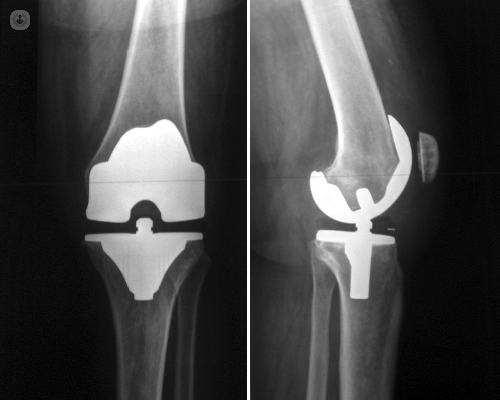When a knee replacement and guarantees offered to the patient is required
Written by:
Knee prosthesis: what it is and what material is made
The knee replacement surgery (arthroplasty or prosthetic devices) is a routine operation which involves replacing damaged tissues, worn or diseased knee, specifically the cartilage and subchondral bone with an artificial joint.Adults of any age can be considered for a knee replacement, but most are held in people between 60 and 80 years. A knee replacement usually lasts more than 20 years, especially if the new knee is maintained properly and not put under too much stress.
The knee prosthesis consists of two main parts, one that binds to the bottom of the femur and another that attaches to the top of the tibia. These two components are metal, usually cobalt-chromium alloys, which are fixed to bone by mechanical means or direct attachment or through surgical cement. Between the two metal components polyethylene an intermediate piece is placed a kind of very resistant "plastic" that allows both components to slide over one another in the movements of the knee.

When an operation knee replacement with a prosthesis is necessary
The knee replacement surgery is usually necessary when the knee joint is worn or damaged, resulting in reduced mobility and pain even at rest.
The most common reason for knee replacement surgery is osteoarthritis reason. Other conditions that cause damage in the knee include:- Rheumatoid arthritis- Haemophilia- drop- Bone dysplasia (bone diseases that cause deformity)- Avascular necrosis (death of bone in the knee joint after blood supply problems)- Injuries
Patients who are candidates for knee replacement surgery
A knee replacement is a major surgery, so usually only recommended if other treatments such as physical therapy or steroid injections have not helped to reduce pain and improve mobility.
Therefore, the skilled Traumatology offer surgery knee replacement if:- You have severe pain, swelling and stiffness in the knee joint and mobility is reduced.- Knee pain is so severe that it interferes with their quality of life and sleep, everyday tasks such as shopping or out of the bath, are difficult or impossible.- The patient feels depressed because of pain and lack of mobility.- The patient can not work or have a normal social life.
You also need to have health good enough to cope with a major operation and subsequent rehabilitation.
Alternative surgeries for knee replacement surgery
Alternatives to knee replacement surgery may include:- Washing and arthroscopic debridement: An arthroscope (small vision system) is inserted into the knee, which is then washed with saline to clean away any bone or cartilage.
- Osteotomy: During open surgery, the surgeon cuts the bone of the tibia and realigned so that the weight no longer focuses on the damaged part of the knee
- Mosaicplasty: It is an operation that involves the transfer of hard plugs and healthy cartilage, along with some underlying bone from another part of the knee, to repair the damaged surface
Preparing for knee replacement surgery
A good way to prepare for knee replacement surgery is to stay as active as possible. Strengthening the muscles around the knee will be helpful for recovery. If the patient can, will continue to do gentle exercise, like walking and swimming, in the weeks and months before surgery. It can lead to a physiotherapist, who will give you useful exercises.
The expert doctor will ask the patient Traumatology preoperative study that may include blood tests, electrocardiogram, chest radiography and consultation with a specialist in anesthesia. This will see what medication you are taking and if you need to suspend or modify before surgery. The operation may require blood transfusion, so reserve crossmatch and blood or other therapeutic measures were also requested.
Recovery from knee replacement surgery or knee replacement
Usually, the patient is in the hospital for three to five days, but the recovery time can vary depending on the person and the type of surgery performed.
Once discharged, the hospital will give the patient advice on the care of his knee at home. You will need to use a walker or crutches at first and a physiotherapist will teach you exercises to help strengthen your knee.
Most people can stop using walking aids around six weeks after surgery, and start driving after approximately eight to 12 weeks.A very small number of people continue to experience some pain after two years.
Duration of the knee prosthesis
Replacements or knee replacement wear. Unfortunately, an artificial knee is not as durable as the knee itself. The good news is that studies show that common types of knee replacements can last more than 20 years. The patient must remember that while some patients may have knee replacements that last several decades, other patients may require a revision operation just a few years after surgery. A recent report found that only 2% of surgeries knee prosthesis require a second surgery within five years after the initial surgery.
Some of the factors that seem to influence the longevity of knee replacement include:
- Age of the patient. Younger patients tend to be more active. Therefore, patients with knee under age 50 can expect revision surgery- Activities of patients. Some activities may not be appropriate for patients with knee. While these activities may not be painful or difficult, they may be putting undue stress on the prosthesis, causing parts to wear out faster.- Patient weight. The more an individual weighs, the more stress experienced by prosthetic components. Maintaining a normal body weight is vital when it comes to making a joint replacement.- Avoiding complications. This may sound obvious, but there are some specific medical conditions that can lead to complications affecting the joint replacement. Patients having invasive medical procedures (including dental work) may require antibiotic treatment to prevent bacteria from entering the prosthesis. Patients with osteoporosis should ensure that they are being adequately treated as a fracture in the bone around the prosthesis may affect the performance of the implant.
Edited by Patricia Crespo Pujante


